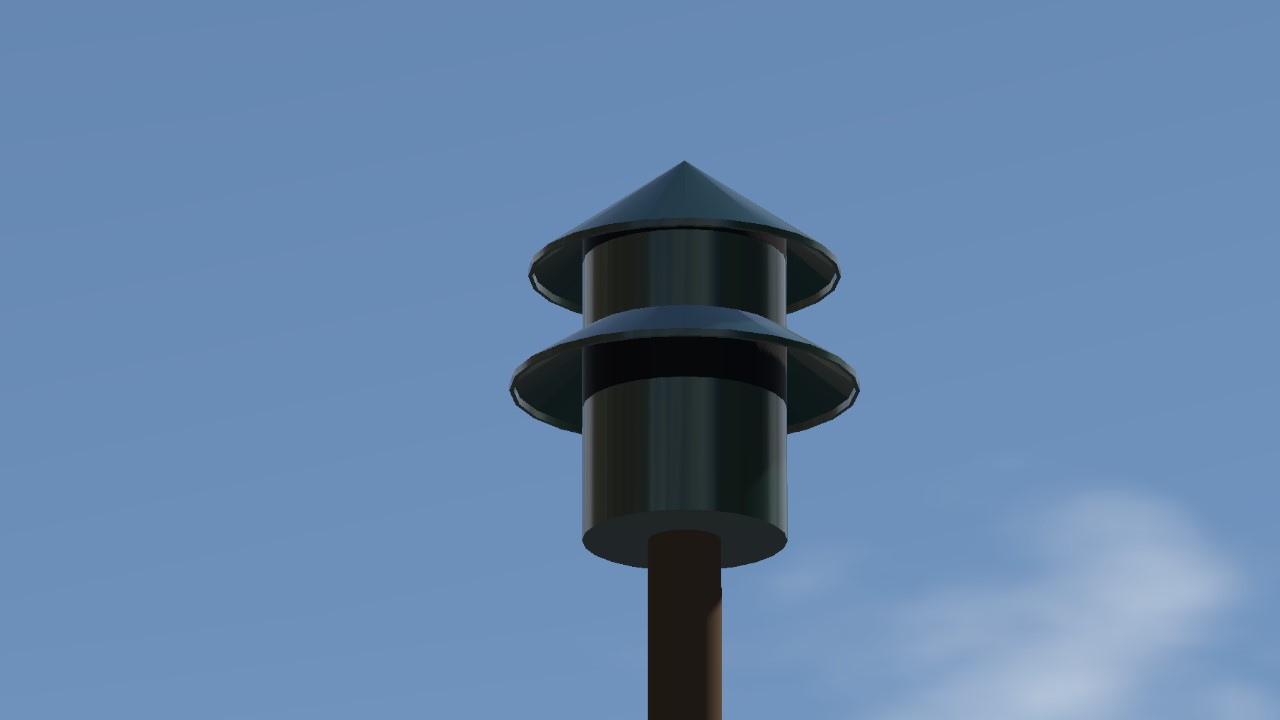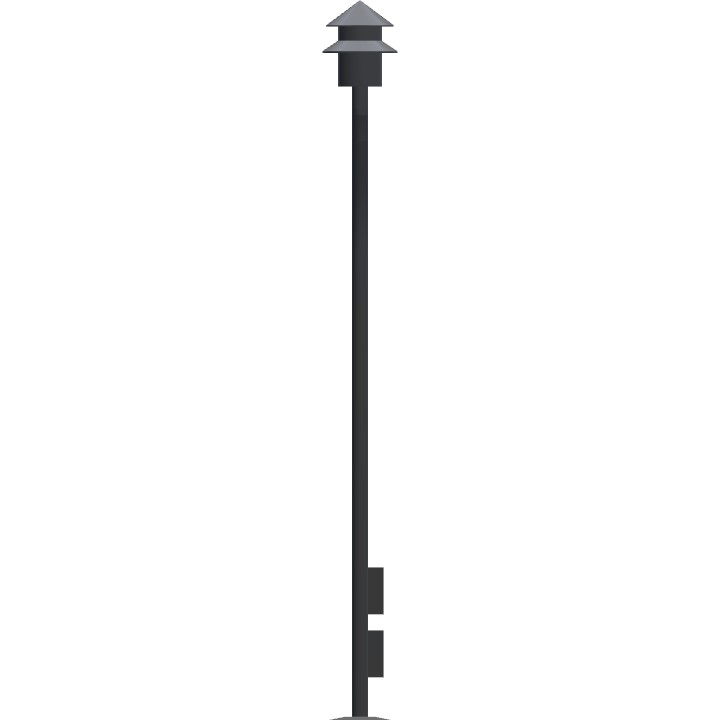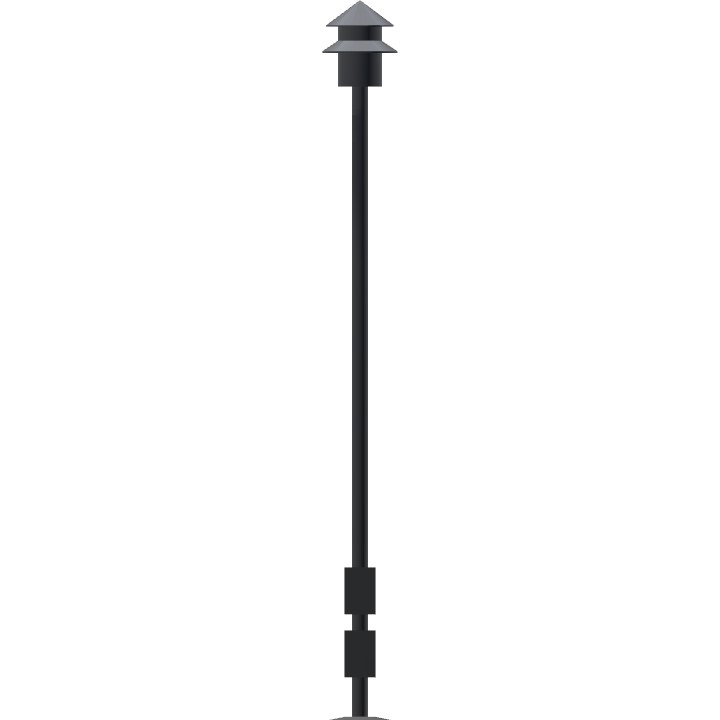RESUME
The Federal Signal Model 5, also called the General Alarm Siren or Vertical Siren, refers to a line of medium sized omnidirectional sirens produced by Federal Signal over the span of 50 years, going through many design changes and variants throughout that time. Despite being discontinued in 1987, they remain a very common sight throughout The United States and Canada. They were also rebranded and resold by other siren manufacturers, such as GCS and W.S. Darley & Co.
While the Model 2 is part of this lineup, it has its own page and will not be covered in this article. See link for more details.
HISTORY
This lineup is a design refresh of the Fedelcode series of sirens was discontinued upon Federal Electric's rebranding to Federal Enterprises in 1948. The lineup by then had been streamlined to the Models "1", "2", "C1 ½", "C2 ½", and "C3 ½". The primary design changes included added screens for the output and intake, and most notably a wider, less steep bottom skirt. As it became common practice to mount sirens on wooden poles or metal towers instead of on roofs, this design change helped them to project better than the Fedelcode which was designed with roof mounts in mind.
Dual tone variants of the C2 and C3 models became available in the 1950s as Office of Civil Defense requirements necessitated sirens used for that purpose to be distinct from typical single toned fire and general purpose sirens. These used the 9/12-port core from the SD-10 and were produced alongside the single tone models up until the series was discontinued entirely. These were typically suffixed with "T" or "TT" on the tags to differentiate them.
In May 1967, the C1 1/2 and C2 1/2 were discontinued entirely, along with the 7.5 horsepower and 10 horsepower variants of the C3 1/2. This left only the 5 horsepower C3 ½ in production. To reflect this, Federal Signal opted to simply name the siren the Model 5. The 8-port units ceased production around the same time, leaving 12-port single tone and 9/12-port dual tone as the only options.
The Model 5 was discontinued in 1987, due to decreasing sales as fire sirens were replaced by pagers and seen as obsolete. The series partially lives on through the 2001 series, which use the 15" rotor from the C2 ½. Federal Signal released the Model ECLIPSE in 2006, which has taken the Model 5's purpose as a general purpose/fire siren while also succeeding the STH-10. Today, the C3 ½ is one of the most common sirens in North America, being found at fire stations, factories, and other places across the continent. It is only beaten by the Model 2.
The sirens in this series were sold by various third party companies who partnered with Federal Signal, such as GCS and W.S. Darley & Co. These sirens had their own custom housings but had identical cores to their basic Federal counterparts, which makes the difference only cosmetic. These would be produced from the 1940s until around the 1960s as the companies either switched to producing other companies' sirens or going out of business. Due to the simple and effective design of the Model 5's housing, many other manufacturers replicated it with their own sirens such as H.O.R. and Thibault, though the cores of their sirens were of their own designs.
DESIGN
The "Model 5" consists of three different sized models, the C1 ½, C2 ½, and C3 ½. With the exception of the C1 ½, each model came with a variety of different horsepower motors which makes discerning the exact model impossible without reading the tag, as Federal named the sirens based on horsepower alone and different sized models could share motor horsepower ratings.
All models consist of a siren core protected by a weatherproof housing resembling a roof vent which helps to protect the siren core from rain and snow while still allowing sound to project away from the siren. This housing contains two openings where air is drawn in and sound is projected out. A conical rainshield is placed atop the siren to keep debris and moisture out of the chopper, and a single skirt is placed above the lower opening to project sound downwards and outwards.
From 1948 until 1959, C2 ½ and C3 ½ models included a service panel for the motor, which was likely removed as it could fall off and compromise the weatherproof housing. If maintenance was necessary, removing the housing entirely was easy. The design of the sirens was finalized after Federal Enterprises became Federal Sign & Signal in 1954 and they would remain largely unchanged throughout the rest of the series' production run. Dual tone units tended to perform slightly worse than their single tone counterparts.
Like their Fedelcode counterparts, early units were available with the option to add a damper, which used a motor-driven (early) or electromagnetic (later) damper to block and unblock the siren's intake, allowing it to produce a "pulse" of sound. This was used to tell volunteer firefighters where a fire was, using a numbered series of "fire zones" and blasting a number of pulses corresponding to which zone the fire was in. These coded models generally have the "OC" suffix, such as the Type 5OC or Type 7OC for example. The coded variant of the C1 ½ was discontinued first in 1953, and the C2 ½ and C3 ½ code sirens were discontinued entirely by the mid to late 1950s after code sirens were made obsolete by the speed of radio communication.
The sirens make use of either an 8 or 12-port single tone chopper and stator, powered by a motor of varying horsepower. 12-port is by far the most common, as it was the standard. 9/12 port dual tone models were available for civil defense use as well, but only on C2 and C3 models. They were all available with single phase brushed or three phase induction motors, with units produced between 1976 and 1987 suffixed as "B" or "A" respectively. Units produced before 1976 do not include any suffixes. Single phase models tend to be physically taller than three phase models (though not always) due to the increased height of the motors. This is because the single phase units need an additional section for the brushes.
MODELS
C1 1/2 (Type 3)
The C1 ½ is the smallest sized siren in the lineup. The C1 ½ bridges the gap between the Model 2 and the larger sirens in the series. The C1 ½ makes use of a 13" aluminum chopper, which was available in only 12-port single tone. No 8-port models are known to have been produced. Because this siren is driven by a 3 hp AC motor exclusively, all C1 ½ units are guaranteed to be named Type 3. While confirmed to exist, no single phase models have been strictly identified, though it is presumed they would be slightly taller than three phase models like other models in the series.
The C1 ½ is easy to differentiate from the other two models. The C1 ½ uses a shorter weatherproof housing with a single small skirt helping to project the sound downwards and outwards from the rotor. There are only 4 openings underneath the skirt with a mesh screen that exposes the chopper and stator, as well as 4 openings above the skirt where the intake draws in air. The C1 ½ has a distinctly short housing due to the small motor used, and the skirt is much smaller than the larger models and is not as wide as the top rain shield. The C1 ½ also lacks an eyebolt on the housing, as the A-frame typically found on larger models was often substituted with a length of angle iron, if not excluded completely. Lacking the A-frame, the housing is attached to the siren by several screws instead.
The C1 ½ was the first in the series to be discontinued entirely, with production ending in May 1967 according to Federal bulletin No. 115. The siren did not perform much better than the Model 2, which was much smaller, cheaper, and consumed less power, and provided poor value to the customer. For these reasons, the C1 ½ sold poorly compared to the C2 and C3. The C1 ½ is the rarest model today, with few in service and in private possession compared to the other models. The siren was also sold under Federal Electric for a short period, with their own special housing designs, commonly mistaken as GCS sirens. It is unknown if W.S. Darley & Co. or GCS ever sold this model, though it is unlikely.
C2 1/2 (Type 3/5)
The C2 ½ is the middle-sized siren in the lineup. The C2 ½ is a step up from the C1 ½, using a 15" aluminum rotor. The siren was originally available in 8 or 12-port single tone, and 9/12-port dual tone became an option soon after. The siren is driven by either a 3 hp or 5 hp AC motor, with 5 hp being by far the most common for this size. The C2 ½ was able to reach 107 dB at 100 ft, which closely matches the performance of the larger C3 ½. 3 horsepower models are named Type 3, while 5 horsepower models are Type 5.
Unlike the C1 1/2, there are five screened openings underneath both skirts instead of four, allowing air and sound to pass through. The housing itself is secured to the siren using an A-frame attached to the stator, held together by two bolts. An eyebolt connects the A-frame with the top of the housing, which the C1 ½ lacks.
1 ph models can often (though not always) be differentiated by their slightly taller housings compared to the 3 ph models, due to often using a taller motor.
A dual tone model was available, reusing the chopper and stator from the SD-10. The 5 hp Type 5TT (occasionally stamped as 5T) was designed with civil defense requirements in mind, and was often installed as a supplementary siren alongside larger sirens. These were painted yellow from the factory to differentiate them from standard units.
The 3 horsepower variant of this siren was discontinued in May 1967, leaving only the 5 horsepower variant. The C2 ½ was discontinued entirely by 1976, when FS&S became the Federal Signal Corporation. The C2 ½ was redundant, as it performed near identically to the C3 ½, and it was not worth the cost of producing two similarly performing sirens with the same horsepower.
C3 1/2 (Model 5/7/Type 10)
The C3 ½ is the largest, loudest, and most successful siren of the lineup. The C3 ½ is a significant step up from the previous models, using an 18" aluminum rotor. The siren was available in 8 or 12-port single tone, or 9/12-port dual tone. The siren is driven by a 5, 7.5, or 10 hp AC motor, although all are more or less identical in performance and appearance. These are named Type 5, 7, or 10 depending on the motor horsepower. The siren was available in 1 or 3 ph AC.
The C3 ½ was able to reach 110 dB at 100 ft, closely matching the performance of the C2 ½, though the frequent changes in housing proportions could enhance or worsen performance by generation. Dual tone variants performed at only 108 dB at 100 ft.
The original reason for the C3 ½'s existence was to skirt regulations about motor horsepower and is the reason why the C3 ½ ultimately became the standard model. The 7.5 hp and 10 hp models were discontinued in May 1967, due to their lack of significant increase in volume over a standard 5 hp model. All units produced after this date are guaranteed to be Model 5s.
The C3 ½ can be told apart from the other models by its significantly wider skirt, which helps project the sound from the rotor downwards and outwards evenly. This skirt could be customized from the factory, as one was ordered with an even larger skirt than normal. The C3 ½ is the only known model to include an intake cone/tube. Originally, Federal experimented with conical intakes for the C3 ½, with a custom flat sided A-frame to fit the extra wide intake. This was later simplified to a straight cylindrical intake to make room for a normal A-frame and to save on materials.
Specifications
General Characteristics
- Created On Windows
- Wingspan 3.9ft (1.2m)
- Length 3.9ft (1.2m)
- Height 37.5ft (11.4m)
- Empty Weight 1,462,731lbs (663,484kg)
- Loaded Weight 1,462,731lbs (663,484kg)
Performance
- Wing Loading N/A
- Wing Area 0.0ft2 (0.0m2)
- Drag Points 3926
Parts
- Number of Parts 13
- Control Surfaces 0
- Performance Cost 32
Required Mods
-
Tone Generator
by hpgbproductions
Version 1.3 (5/19/2021 4:33:21 PM)
View Mod Page





If you want to be tagged in future posts, go to this forum (PC Only)
Tag list pt.5
@Ac3Zodiac
@Ashdenpaw1
@AviationLoverGEEK444
Tag list pt.4
@Odoggg
@voytek
@Mrcooldude
Tag list pt.3
@X99STRIKER
@THEROCKMAN1
@SchmooveBrain
Tag list pt.2
@DeeganWithABazooka
@THEOKPILOT
@CrestelAeronautics
Tag list
@Morsele
@YOURGORILLA1246
@RedeemedSPer